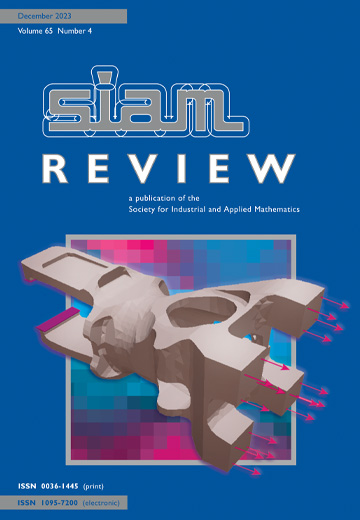调查和审查
IF 6.1
1区 数学
Q1 MATHEMATICS, APPLIED
引用次数: 0
摘要
SIAM Review》第 66 卷第 2 期第 203-203 页,2024 年 5 月。 逆问题在各种应用中都会出现,例如在地球科学、生物医学或采矿工程等领域。其目的是从通常受噪声影响的测量数据中恢复物体或现象。文章 "大规模逆问题的计算方法:Julianne Chung 和 Silvia Gazzola 撰写的文章 "大型逆问题的计算方法:混合投影方法概览 "重点讨论了大型逆问题,主要是线性逆问题。此类问题的数学建模会产生一个线性系统,该系统具有一个非常大的矩阵 $A \in \mathbb{R}^{m\times n}$,以及一个扰动右边。在某些应用中,甚至无法存储该矩阵,因此只能使用矩阵向量积 $Ax$ 或 $A^Tx$ 形式的 $A$ 算法。文章从图像去模糊和断层重构的两个例子入手,说明了逆问题所面临的挑战。然后,文章介绍了正则化的基本思想,即通过附加信息来增强模型。文中详细介绍了正则化方法的两种变体,即变异法和迭代法。对于变异方法来说,事先知道一个好的正则化参数至关重要。遗憾的是,估计参数的成本可能很高。另一方面,迭代方案(如 Krylov 子空间方法)通过提前终止迭代来正则化。混合方法结合了这两种方法,充分利用了每一类的最佳特征。本文重点介绍混合投影方法。在这种方法中,首先是一个克雷洛夫过程,在这个过程中,原始问题被投影到一个低维子空间上。然后使用变分正则化方法解决投影问题。本文回顾了最相关的直接正则化技术和迭代正则化技术,然后详细介绍了混合方法的两个主要组成部分,即生成求解子空间和求解投影问题。它涵盖了这些方案的理论和数值方面,还介绍了混合方法的一些扩展:更一般的 Tikhonov 问题、非标准投影方法(丰富、增强、回收)、$\ell_p$ 正则化、贝叶斯设置和非线性问题。此外,还提供了相关的软件包。论文的表述非常清晰,非该领域专家也能读懂。因此,它对所有对大规模逆问题感兴趣的人都很有价值。本文章由计算机程序翻译,如有差异,请以英文原文为准。
Survey and Review
SIAM Review, Volume 66, Issue 2, Page 203-203, May 2024.
Inverse problems arise in various applications---for instance, in geoscience, biomedical science, or mining engineering, to mention just a few. The purpose is to recover an object or phenomenon from measured data which is typically subject to noise. The article “Computational Methods for Large-Scale Inverse Problems: A Survey on Hybrid Projection Methods,” by Julianne Chung and Silvia Gazzola, focuses on large, mainly linear, inverse problems. The mathematical modeling of such problems results in a linear system with a very large matrix $A \in \mathbb{R}^{m\times n}$ and a perturbed right-hand side. In some applications, it is not even possible to store the matrix, and thus algorithms which only use $A$ in the form of matrix-vector products $Ax$ or $A^Tx$ are the only choice. The article starts with two examples from image deblurring and tomographic reconstruction illustrating the challenges of inverse problems. It then presents the basic idea of regularization which consists of augmenting the model by additional information. Two variants of regularization methods are considered in detail, namely, variational and iterative methods. For variational methods it is crucial to know a good regularization parameter in advance. Unfortunately, its estimation can be expensive. On the other hand, iterative schemes, such as Krylov subspace methods, regularize by early termination of the iterations. Hybrid methods combine these two approaches leveraging the best features of each class. The paper focuses on hybrid projection methods. Here, one starts with a Krylov process in which the original problem is projected onto a low-dimensional subspace. The projected problem is then solved using a variational regularization method. The paper reviews the most relevant direct and iterative regularization techniques before it provides details on the two main building blocks of hybrid methods, namely, generating a subspace for the solution and solving the projected problem. It covers theoretical as well as numerical aspects of these schemes and also presents some extensions of hybrid methods: more general Tikhonov problems, nonstandard projection methods (enrichment, augmentation, recycling), $\ell_p$ regularization, Bayesian setting, and nonlinear problems. In addition, relevant software packages are provided. The presentation is very clear and the paper is also readable for those who are not experts in the field. Hence, it is valuable for everyone interested in large-scale inverse problems.
Inverse problems arise in various applications---for instance, in geoscience, biomedical science, or mining engineering, to mention just a few. The purpose is to recover an object or phenomenon from measured data which is typically subject to noise. The article “Computational Methods for Large-Scale Inverse Problems: A Survey on Hybrid Projection Methods,” by Julianne Chung and Silvia Gazzola, focuses on large, mainly linear, inverse problems. The mathematical modeling of such problems results in a linear system with a very large matrix $A \in \mathbb{R}^{m\times n}$ and a perturbed right-hand side. In some applications, it is not even possible to store the matrix, and thus algorithms which only use $A$ in the form of matrix-vector products $Ax$ or $A^Tx$ are the only choice. The article starts with two examples from image deblurring and tomographic reconstruction illustrating the challenges of inverse problems. It then presents the basic idea of regularization which consists of augmenting the model by additional information. Two variants of regularization methods are considered in detail, namely, variational and iterative methods. For variational methods it is crucial to know a good regularization parameter in advance. Unfortunately, its estimation can be expensive. On the other hand, iterative schemes, such as Krylov subspace methods, regularize by early termination of the iterations. Hybrid methods combine these two approaches leveraging the best features of each class. The paper focuses on hybrid projection methods. Here, one starts with a Krylov process in which the original problem is projected onto a low-dimensional subspace. The projected problem is then solved using a variational regularization method. The paper reviews the most relevant direct and iterative regularization techniques before it provides details on the two main building blocks of hybrid methods, namely, generating a subspace for the solution and solving the projected problem. It covers theoretical as well as numerical aspects of these schemes and also presents some extensions of hybrid methods: more general Tikhonov problems, nonstandard projection methods (enrichment, augmentation, recycling), $\ell_p$ regularization, Bayesian setting, and nonlinear problems. In addition, relevant software packages are provided. The presentation is very clear and the paper is also readable for those who are not experts in the field. Hence, it is valuable for everyone interested in large-scale inverse problems.
求助全文
通过发布文献求助,成功后即可免费获取论文全文。
去求助
来源期刊

SIAM Review
数学-应用数学
CiteScore
16.90
自引率
0.00%
发文量
50
期刊介绍:
Survey and Review feature papers that provide an integrative and current viewpoint on important topics in applied or computational mathematics and scientific computing. These papers aim to offer a comprehensive perspective on the subject matter.
Research Spotlights publish concise research papers in applied and computational mathematics that are of interest to a wide range of readers in SIAM Review. The papers in this section present innovative ideas that are clearly explained and motivated. They stand out from regular publications in specific SIAM journals due to their accessibility and potential for widespread and long-lasting influence.
 求助内容:
求助内容: 应助结果提醒方式:
应助结果提醒方式:


